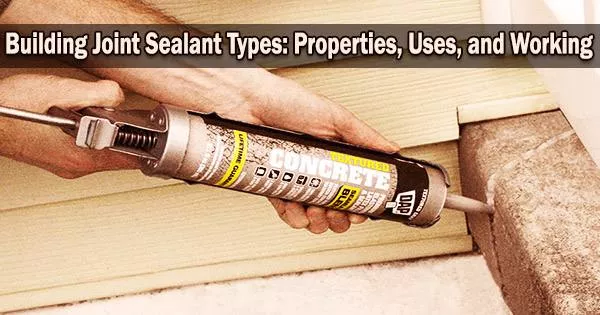A compound called sealant is used to seal the seams between several types of construction materials, including brick walls, glass, aluminum, and concrete. In order to protect the structures from damage brought on by stresses, joints are typically given.
Properties of Good Sealant
Different types of sealants with good properties are available. The basic properties of a good sealant should be as follows.
- The sealant should have good bond with building materials.
- The sealant should be soft.
- It should be flexible.
- It should not affected by the weather changes.
- It should strong against stress and stress relief cycle.
Types of Sealants Used for Joints in Buildings – Properties and Uses
There are several types of sealants are:
- Silicone based sealants
- Urethane based sealants
- Acrylic based sealants
- Polysulphide based sealants
Out of the above sealants, Polysulphide sealants are more popular in construction world.
Polysulphide based Sealant
Polysulphide sealants are widely used because of good sealant properties. They are basically applied in cold conditions. Polysulphide sealants are available in two types of systems:
- Two-part system
- One-part system
- Two-part system
The base and accelerator are two components of this sealant system. These two ought to be blended together to create a sealant. After being combined, they both chemically react and form a thick paste. After mixed, this paste must be utilized within 48 hours.
After applying sealant it will take 8 days for full curing. Dual-stage system There are two distinct varieties of polysulfide sealant: gun grade and pour grade. While pour grade is used for horizontal joints, gun grade is used for inclined joints, vertical joints, and overhead joints.
One-part system
One-part system contains premixed sealant which can be directly used without any mixing. They are capable of absorbing moisture form the atmosphere and reaction occurs. In this case full curing of sealant will take 3 to 4 weeks.
Uses of Polysulphide based Sealants
Polysulphide based sealants are used in different areas of constructions as follows:
- Building structures joints like basements, glazing frames, ceiling joints, floors, roofs, external walls, cladding, retaining walls etc.
- Water retaining structures joints such as dams, reservoirs, canal linings, culverts etc.
- Joints in bridges, roads, aerodromes etc.
Equipment for Polysulphide based Sealants Application
Sealant should be applied with proper equipment. The equipment should be as follows:
- Filling device
- Gun
- Mixer
- Spatula
- Backup material
- Bond breakers
- Masking tape
Filling Device
The sealant shouldn’t be mixed or prepared and left out in the air for too long. In order to use sealant directly, a proper filling device is used, which can be attached to the gun. It is well suitable for large scale works (30N or more sealant).
Gun
The gun is a device which include PVC made cartridges and nozzles to deliver the sealant. Using this gun with sealant can be easily placed in the joints in any position.
Mixer
Mixer is usually required for two-part sealant system. So, the base and accelerator should be mixed effectively.
Spatula
Spatula can be used as alternative for gun but it is suitable for small quantity works. Accessories are needed for sealant, which can help with application, in addition to equipment.
Backup material
Back up material controls the depth of sealant in the joint.
Bond breakers
Bond breakers in the form a tape is made of PVC or metal or paper. Three face adhesion can be prevented by using bond breakers.
Masking tape
Spreading of the sealant during application in the joints runs the risk of damaging the joint’s sides. To prevent this masking tape is provided on both sides of joint. Some time it may not be used if the skilled persons are working.
Working Conditions of Polysulphide based Sealants
- Temperature (application and service)
- Size of joint
- Storage of sealant
- Water resistance
- Chemical resistance
- Setting time and cure time
- Movement
- Durability
Temperature (application and service)
While applying sealant the temperature range should be 5o C to 50o C. And the sealant can work or service effectively in the temperature range of -40o C to +80o C.
Size of joint
The width of joint should be 5 mm to 50 mm. the depth of sealant applied in the joint should be 5 mm for metal and glass structures and 10 mm for concrete and brick joints.
Storage of sealant
The mixed paste of two-part system sealant can be stored up to 12 months in dry and cool place in closed container.
Water resistance
After full curing the sealant will resist water and impermeable.
Chemical resistance
Chemical resistance of sealant is very great and they offer great resistance against oils, petrol, white spirit, fuels etc.
Movement
Movement of sealant after applying is 25% for butt joints and 50% lap joints.
Durability
In traffic surfaces such as roads, bridges the sealant can last up to 10 years while in other cases it can last up to 25 years.
















